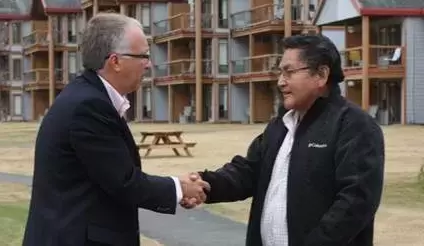Tla-o-qui-aht First Nation leaders signed an agreement with the provincial government Aug. 1 that will allow the parties to share revenue from a run-of-the river hydro project that the first nation is about to begin construction on.
The Haa-ak-suuk Creek Power Project received equity funding to the tune of $500,000 in 2012 from the B.C.’s First Nations Clean Energy Project. The project will be located in the Kennedy River Watershed.
B.C.’s First Nations Clean Energy Business Fund provides money to build capacity in First Nations communities and invest in clean energy infrastructure.
Aboriginal Relations and Reconciliation Minister John Rustad, speaking from the lawn of the TFN-owned and operated Tin Wis Best Western Resort, commented on the beauty of the place.
“It is a testament to the entrepreneurial spirit of Tla-o-qui-aht First Nation,” he noted.
TFN’s first run-of-the-river micro hydro project is located at Canoe Creek on the Tofino highway. Minister Rustad said the new project will build on TFN’s previous successes.
The Canoe Creek Run of the river project has been operating since June 2010 generating 5.5MW of electricity; enough to power 3,000 Vancouver Island homes. TFN owns 75 per cent of the Canoe Creek Project.
Haa-ak-suuk Creek Power Project is now under construction, employing a few TFN members. TFN Councillor Saya Masso said the power projects do not generate many jobs, but the benefits come through the revenue the plants generate which goes directly to the community.
There will be a few jobs for band members during the construction phase and then the plant must be maintained.
The Haa-ak-suuk Creek Power Project is expected to be complete in December 2013 and will be owned 85 per cent by TFN. It is expected to generate about $38,000 per year over the life of the project.
This is the second such agreement in British Columbia and we hope to do more, said Rustad. The first such agreement was signed earlier this year with Tahltan Nation.
“These projects generate economic opportunities; we are going to need power and it’s a great way to meet BC’s growing energy needs,” said Minister Rustad.
B.C.’s First Nations Clean Energy Fund has invested $3.8 million in energy projects since 2011.
Minister Rustad took his seat as Aboriginal Relations and Reconciliation Minister in June 2013; he was given a mandate to create at least 10 non-treaty agreements by 2015.
“We are trying to build government-to-government relationships and to find ways to work together, move forward and progress together,” said Rustad.
Jamie Basset, Economic Development Officer for Tla-o-qui-aht First Nation, said TFN has a long-term plan of building more clean energy projects. Winchie Creek Hydro is the third of TFN’s energy project in the works and Bassett expects the required water licenses to be in place by the end of summer 2013.
Once complete, the Winchie Creek Hydro Project will be owned 100 per cent by TFN. It will be the third of eight planned power projects for Tla-o-qui-aht.
TFN Chief Councillor Moses Martin said his nation welcomes the opportunity to create wealth through sustainable development in their traditional territories.
“Taking care of the land and sharing what we have is part of our traditions,” he said.
“TFN is proud to be participating in the green energy industry; we have many dreams and goals both in green economic development and in our vision for the future of the community,” said TFN Councillor Saya Masso.







